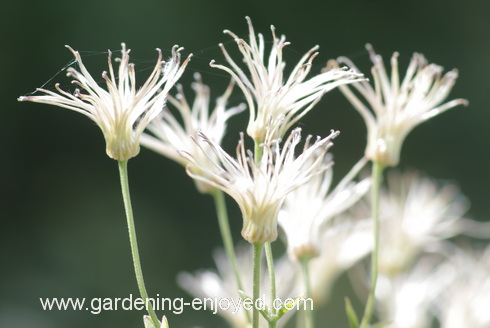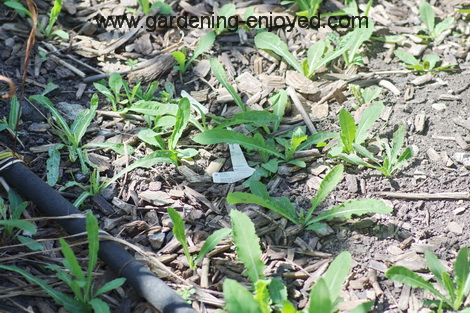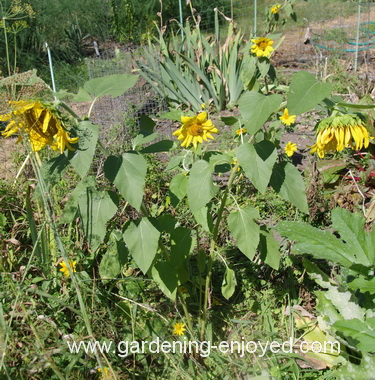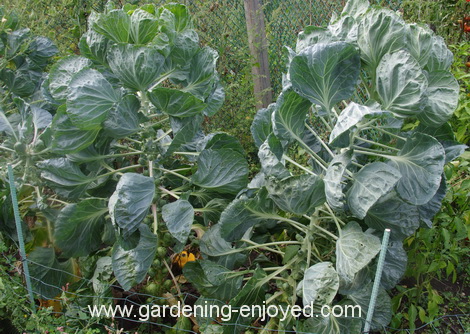| Back to Back Issues Page |
 |
|
Dallying In The Dirt, Issue #384 - The no mildew Impatiens were a great success. September 12, 2021 |
This picture is obviously not the grandchildren but rather the seed pods of Clematis aromatica which are arguably more delightful than the flowers especially if you can catch them with some great backlighting. It’s a shrubby type of Clematis that will be cut back to the ground each year and allowed to climb this ancient gate that is placed in the garden just for it. It’s not quite shrubby enough to stand without some support. This issue of Dallying will be a bit longer than usual to try and catch up on the many things that have been happening in the garden. 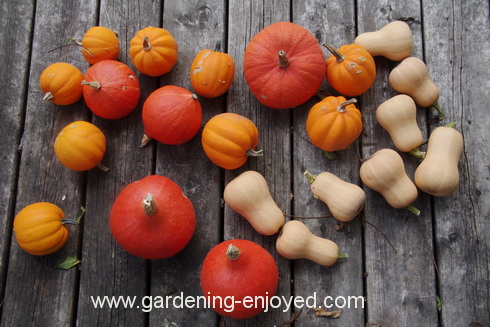 Autumn brings harvest time and this year was a good year for Squash. All four varieties produced well, some better than others. We like a squash with a good rich flavour and we are slowly trying each type to see which ones we prefer. The yellow Acorn, Goldilocks was a 2021 All America winner but it was not our favourite. Nice compact plant with a high yield but the flavour was a bit mild for our tastes. All is not lost, it will make a nice soup with maybe a bit of curry added. If you have limited space it is a great choice. All of these Squash are sitting on the deck in the sunshine curing so that they will last longer in the basement over the winter. We like our Squash but would prefer not eating it 20 nights in a row.
Autumn brings harvest time and this year was a good year for Squash. All four varieties produced well, some better than others. We like a squash with a good rich flavour and we are slowly trying each type to see which ones we prefer. The yellow Acorn, Goldilocks was a 2021 All America winner but it was not our favourite. Nice compact plant with a high yield but the flavour was a bit mild for our tastes. All is not lost, it will make a nice soup with maybe a bit of curry added. If you have limited space it is a great choice. All of these Squash are sitting on the deck in the sunshine curing so that they will last longer in the basement over the winter. We like our Squash but would prefer not eating it 20 nights in a row.
 These little flashes of pink caught my eye the other day as I was walking past this garden. I stopped and realized that they were the seeds in the opened seed pods of my species Peony Molly the Witch. Now I have a dilemma. The curious horticulturist is intrigued by these seeds and the possibility to germinate and grow them. The aging gardener who is trying to downsize is reading the instructions for growing Peonies from seed and wondering if he wants to undertake what is probably a five year process to get a flowering plant. Soak in water for a few days, a few months in damp peat moss in the fridge, then into some warmth and look for roots to emerge, then transplant and let them develop for the next 3 - 4 years. I can tell you that they are now in the fridge.
These little flashes of pink caught my eye the other day as I was walking past this garden. I stopped and realized that they were the seeds in the opened seed pods of my species Peony Molly the Witch. Now I have a dilemma. The curious horticulturist is intrigued by these seeds and the possibility to germinate and grow them. The aging gardener who is trying to downsize is reading the instructions for growing Peonies from seed and wondering if he wants to undertake what is probably a five year process to get a flowering plant. Soak in water for a few days, a few months in damp peat moss in the fridge, then into some warmth and look for roots to emerge, then transplant and let them develop for the next 3 - 4 years. I can tell you that they are now in the fridge.
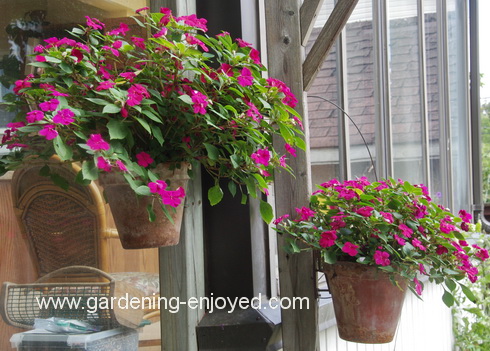 And here is another mystery? I tried one, Imara x, of the two new varieties of mildew resistant Impatiens and they grew well, with no sign of that horrible downy mildew. The mystery is in the size of the growth in these two adjacent pots. They almost touch each other but as you can see one is much larger then the other. They are positioned such that one is in almost full sun, the shorter one and the taller one is around the other side of the post and gets noticeably less sun. The bright sun obviously keeps the plants thriving but with much shorter internodes while the slightly shaded one is stretching a bit to reach that reduced sun. A couple of other pots that are in heavier shade did grow reasonably well but not nearly as full as either of these two. My unscientific conclusion is that whatever they did to introduce the disease resistance also made them slightly happier with some increased sunlight. I will continue to put Impatiens back into my regular list of
annuals for shade but won’t hesitate to also grow them with lots of sunshine.
And here is another mystery? I tried one, Imara x, of the two new varieties of mildew resistant Impatiens and they grew well, with no sign of that horrible downy mildew. The mystery is in the size of the growth in these two adjacent pots. They almost touch each other but as you can see one is much larger then the other. They are positioned such that one is in almost full sun, the shorter one and the taller one is around the other side of the post and gets noticeably less sun. The bright sun obviously keeps the plants thriving but with much shorter internodes while the slightly shaded one is stretching a bit to reach that reduced sun. A couple of other pots that are in heavier shade did grow reasonably well but not nearly as full as either of these two. My unscientific conclusion is that whatever they did to introduce the disease resistance also made them slightly happier with some increased sunlight. I will continue to put Impatiens back into my regular list of
annuals for shade but won’t hesitate to also grow them with lots of sunshine.I have become quite comfortable doing my presentations on Zoom and one of the big advantages is the ability to speak to groups that are too far away to travel to. I will admit to missing the feel of a live audience but we will continue to Zoom to your meetings as long as we have to. Maybe the long distance capability will be one of the few positive things to develop out of this pandemic. If your group is looking for a knowledgeable and entertaining speaker, check out my web site’s, speaker page. To ask a question just “reply” to this ezine. Don’t forget to check the front page of the Website for frequent short ideas for current gardening activities. Claire Asks? When is the best time of year to transplant Peonies? |
| Back to Back Issues Page |
